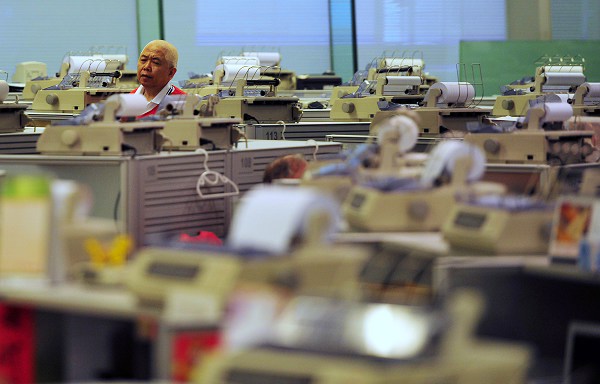Monday, 07 September 2015 12:43
 HONG KONG: Shanghai led most Asian markets lower Monday as early gains were wiped out with dealers in a cautious mood after China revised down its 2014 growth figure and prepared to release more data that will give clues on the slowing economy.
HONG KONG: Shanghai led most Asian markets lower Monday as early gains were wiped out with dealers in a cautious mood after China revised down its 2014 growth figure and prepared to release more data that will give clues on the slowing economy.
A disappointing US jobs report reduced the chances of an interest rate hike later this month, analysts said, providing some support to the Australian dollar which is sitting at around six-year lows against the greenback.
In the face of the latest bout of volatility, G20 finance ministers and central bank heads pledged at the weekend to shore up economic growth and avoid a currency war following China’s yuan devaluation last month that convulsed markets.
Eyes this week are again on Chinese indicators — from inflation and retail sales to trade and investment — that will provide a handle on the state of the world’s number-two economy.
A painful growth slowdown has seen huge losses on global markets — including about 40 percent in Shanghai — despite Beijing’s attempts to provide support, including five interest rate cuts since November.
“The key focus this week would be China as the market reopens,” said Michael McCarthy, chief market strategist at CMC Markets in Sydney. “Investors are increasingly concerned about the slowdown in the Chinese economy,” he said.
There were hefty losses last week after an official gauge of factory activity came in at a three-year low, showing contraction.
And on Monday Beijing said the economy grew last year at a slower rate than initially thought, expanding 7.3 percent instead of the 7.4 percent first stated, its slowest rate in a quarter of a century.
While experts cautioned against reading too much into the manufacturing figures, more soft readings this week could fan selling on fears about a “hard landing” for the economy.
– ‘Fed rate call 50:50’ –
=========================
Markets were given a fillip by comments at the weekend from the head of China’s central bank and its market regulator admitting that there had been “bubbles” but adding that recent turmoil was almost over.
The Shanghai market surged more than 150 percent in the year to mid-June but has since plunged nearly 40 percent.
“Bubbles continued to build up until mid-June,” People’s Bank of China Governor Zhou Xiaochuan told the G20 meeting in Ankara, according to a statement on the PBoC website.
“The correction in the stock market has now come close to an end,” Zhou said, adding the economy was not “much affected” by the rout.
The China Securities Regulatory Commission added: “Gains on the stock market had been too rapid and large, forming stock market bubbles, therefore subsequent plunges and adjustments were inevitable.”
And on Monday China’s top economic planning agency played down growth concerns, saying electricity consumption and railway cargo transport — two indicators Premier Li Keqiang reportedly refers to when gauging the health of the economy — improved in August.
But, after enjoying a morning rally Shanghai stocks — closed Thursday and Friday for a public holiday — ended 2.52 percent lower, while Hong Kong was 0.23 percent off in the afternoon.
Sydney, where several firms reliant on China for business are listed, finished 0.20 percent down. Tokyo ended 0.38 percent higher on bargain-buying while a weaker yen also boosted exporters.
However, the “Aussie” dollar edged up against its US counterpart after Friday’s jobs data muddied the waters for US Federal Reserve policymakers as they decide whether to lift rates this month.
The Labor Department said the economy added 173,000 jobs in August, but revised up the previous two months’ job gains, pushing the unemployment rate down more than expected to 5.1 percent.
“In reality no one, including I, think the FOMC members are closer to knowing whether they will raise rates in September,” said Andrew Sullivan, head of sales trading at Haitong International Securities Group Ltd. in Hong Kong. “The US jobs data make it a 50:50 call.”
On Monday the Aussie was at 69.40 US cents against 69.09 cents Friday, which was a fresh six-year low.
US shares slipped after the jobs figures. The S&P 500 retreated 1.53 percent, the Dow sank 1.66 percent and the Nasdaq lost 1.05 percent.




























